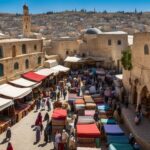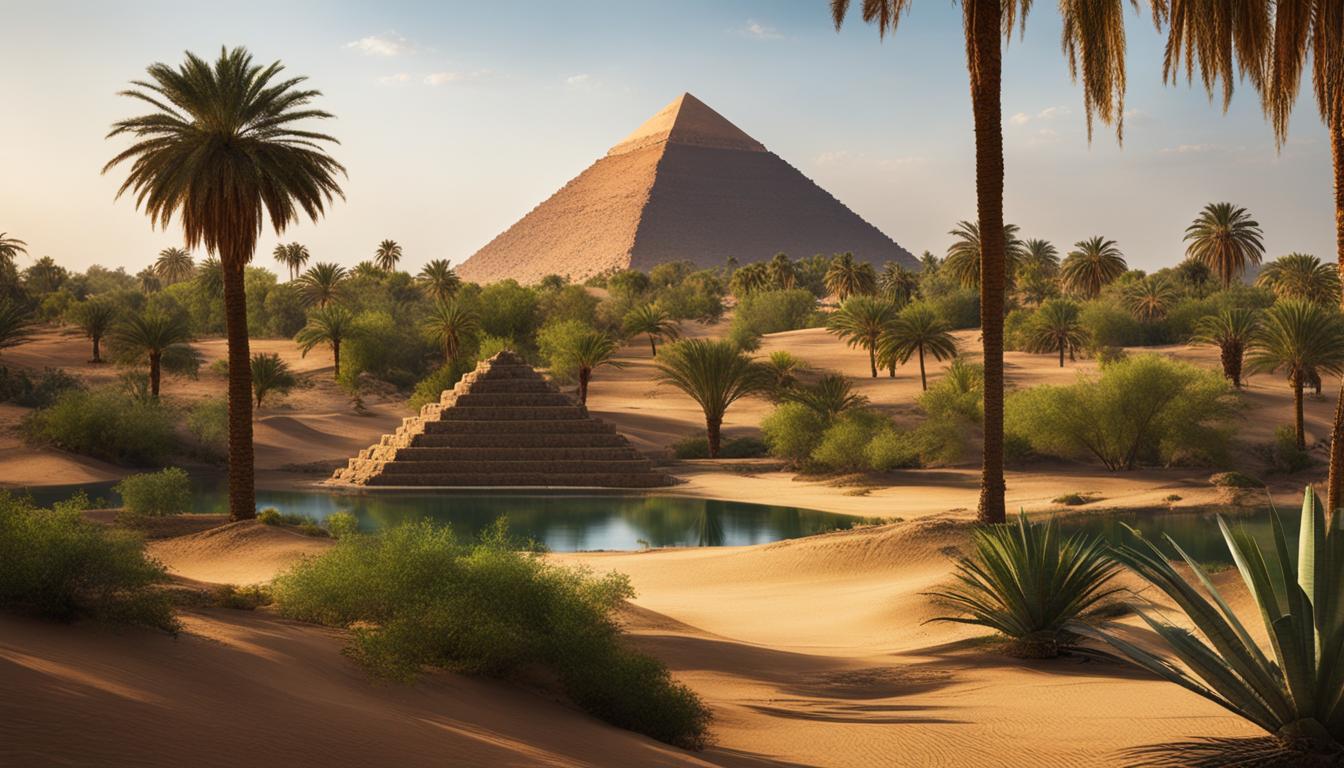Biblical names and places have a rich history and continue to hold significance in our modern world. Whether you are a Christian seeking biblical inspiration for naming your child, or a history enthusiast interested in exploring the locations mentioned in the Bible, these names and places offer a captivating glimpse into the past.
From biblical place names like Jerusalem and Bethlehem to biblical names for boys and girls, such as David, Sarah, and Rachel, these timeless choices carry deep meaning and symbolism. They reflect the stories, faith, and values that have shaped generations.
In this article, we will delve into the enduring influence of biblical names and places and uncover the profound connections they hold to biblical narratives. Join us on this journey through history, faith, and culture, as we explore the significance of these locations and the stories that continue to resonate with us today.
Key Takeaways:
- Explore biblical names and places for meaningful inspiration.
- Discover the historical and religious significance of Jerusalem, Bethlehem, and other biblical locations.
- Learn about the archaeological evidence supporting the biblical narratives.
- Uncover the connection between biblical names and stories within Christian tradition.
- Appreciate the enduring impact of biblical names and places on our faith and culture.
Jerusalem – The Holy City
Jerusalem, known as Salem in the Old Testament, holds immense biblical significance. This holy city is mentioned in various biblical texts, including Psalms and Isaiah, underscoring its importance as a religious and historical landmark. Archaeological excavations in the City of David further validate the biblical connections associated with Jerusalem.
The biblical significance of Jerusalem is deeply rooted in its historical and spiritual heritage. As Salem, it is mentioned in Genesis 14:18 when Melchizedek, the priest-king, blessed Abraham. The city later became the capital of Israel under King David and housed the Ark of the Covenant in the First Temple.
Today, Jerusalem remains a focal point for Jews, Christians, and Muslims, with its Old City recognized as a UNESCO World Heritage site. It stands as a testament to the enduring impact of biblical narratives and is characterized by its sacred sites, including the Western Wall, the Church of the Holy Sepulchre, and the Dome of the Rock.
“The city of the great King” – Psalm 48:2
The City of David, the historical core of Jerusalem, continues to yield archaeological discoveries that shed light on biblical times. Excavations have unearthed structures, artifacts, and inscriptions that further substantiate the biblical accounts associated with the city.
Jerusalem – Quick Facts
| Location | Country | Population |
|---|---|---|
| Eastern Mediterranean | Israel | Approximately 900,000 |
| Notable Sites: | ||
| Western Wall | Holy site for Judaism | |
| Church of the Holy Sepulchre | Christian pilgrimage site | |
| Dome of the Rock | Sacred site for Islam | |
As visitors explore the streets of Jerusalem and engage with its rich cultural and religious diversity, they are enveloped by an awe-inspiring tapestry of history and faith.
Bethlehem – The Birthplace of Jesus
Bethlehem, also known as Ephrath, holds a special place in Christian tradition as the birthplace of Jesus. With a mention in Micah and archaeological findings supporting its biblical importance, the city and the Church of the Nativity continue to be significant sites of devotion.
In the heart of the West Bank, nestled among the Judean hills, lies the picturesque city of Bethlehem. Known as Ephrath in the Old Testament, Bethlehem is renowned as the birthplace of Jesus Christ, making it a place of immense biblical significance.
The mention of Bethlehem in the book of Micah, chapter 5, verse 2, prophesied that Bethlehem would be the birthplace of the Messiah:
“But you, Bethlehem Ephrathah, though you are small among the clans of Judah, out of you will come for me one who will be ruler over Israel, whose origins are from of old, from ancient times.”
These words solidify Bethlehem’s place in the biblical narrative and underscore its importance to Christians around the world.
The Church of the Nativity, located in Bethlehem, stands as a symbol of faith and worship, drawing countless pilgrims each year. Built on top of the grotto believed to be the very site of Jesus’s birth, the Church of the Nativity holds deep spiritual significance for believers.
Inside the church, visitors can find the Nativity Cave, the exact spot revered as the birthplace of Jesus. The cave’s humble setting, adorned with intricate mosaics and ancient artifacts, evokes a profound sense of awe and reverence.
Ancient Origins and Modern Tradition
The history of Bethlehem stretches back thousands of years, with archaeological evidence uncovering ancient artifacts and structures dating back to biblical times. Excavations have revealed the remnants of dwellings and religious buildings, offering glimpses into the lives of past civilizations.
| Table: Key Facts about Bethlehem | |
|---|---|
| Location | Bethlehem, West Bank, Palestine |
| Biblical Significance | Birthplace of Jesus Christ |
| Notable Site | Church of the Nativity |
| Archaeological Discoveries | Remains of ancient dwellings and religious structures |
Today, Bethlehem continues to be a place of pilgrimage and spiritual reflection. Visitors from all corners of the globe gather in the city to celebrate the Christmas season, commemorating the birth of Jesus in the very place where it happened.
As the birthplace of Jesus, Bethlehem holds a cherished place in the hearts of believers worldwide. Its biblical significance, combined with its historical and archaeological importance, make it a must-visit destination for those seeking a deeper connection to their faith and an appreciation for the enduring legacy of biblical narratives.
Hebron – An Ancient Inhabited City
Hebron, once known as Kiriath-Arba, is an ancient city with deep biblical significance. It holds the distinction of being one of the oldest continuously inhabited cities, dating back thousands of years. According to the Book of Genesis, Hebron is associated with Abraham, who lived and settled there. This connection to a prominent biblical figure highlights the city’s historical and spiritual importance.
Archaeological excavations have further contributed to our understanding of Hebron’s ancient origins and its role in biblical narratives. These excavations have uncovered artifacts and structures that provide valuable insights into the city’s past. They enable us to glimpse into the lives of the people who lived there thousands of years ago, bringing the biblical accounts to life.
One notable archaeological discovery is the Hebron Plains Sanctuary, which dates back to the Iron Age. This religious site features a unique architectural design and offers valuable clues about the religious practices and beliefs of the ancient inhabitants of Hebron.
Image:

Nazareth – The Hometown of Jesus
Although not mentioned in the Old Testament, Nazareth is known as the hometown of Jesus. Archaeological evidence, including remains of ancient homes and artifacts, supports its identification as the site linked to the life of Jesus.
Nazareth, a small village located in present-day Israel, holds immense significance as the birthplace of Jesus. While biblical texts do not explicitly mention Nazareth, its association with Jesus stems from the New Testament accounts of his upbringing and ministry. The Gospels of Matthew and Luke state that Mary and Joseph, Jesus’s parents, were from Nazareth, and it is here that Jesus spent his formative years.

Archaeological excavations in Nazareth have unveiled a wealth of historical evidence, providing valuable insights into the ancient village. The remains of ancient homes, household items, and pottery fragments have been discovered, painting a vivid picture of life in Nazareth during the time of Jesus. These findings reinforce the belief that this humble village was indeed his hometown.
Archaeological evidence allows us to connect with the daily lives of people in ancient Nazareth. By studying the artifacts and structures unearthed, we gain a deeper understanding of the world Jesus inhabited and the cultural context in which he grew up.
Exploring the streets of Nazareth today, visitors can marvel at the reconstructed ancient homes, offering a glimpse into the simple dwellings where Jesus and his family may have lived. The Nazareth Village, a living history museum, provides an immersive experience of the biblical era, showcasing traditional agricultural practices, artisan workshops, and a replica of a first-century synagogue.
Archaeological Discoveries in Nazareth
| Discoveries | Significance |
|---|---|
| Remains of ancient homes | Provide insights into the architecture and daily life during Jesus’s time |
| Household items | Offer a glimpse into the material culture and domestic activities of the residents |
| Pottery fragments | Help understand the trade and craftsmanship prevalent in the village |
The archaeological evidence from Nazareth validates its place in the narrative of Jesus’s life and allows us to better comprehend the historical context of the biblical accounts. This ancient village continues to be a significant pilgrimage site for Christians worldwide, drawing visitors who seek to connect with the roots of their faith.
Capernaum – A Place Connected to Jesus’s Ministry
Capernaum, also known as Kfar Nahum, is a significant location associated with many events from Jesus’s ministry. The archaeological excavations conducted in Capernaum have yielded fascinating discoveries, shedding light on the ancient ruins and providing valuable insights into the time when Jesus lived and taught.
One of the most remarkable findings in Capernaum is the ancient synagogue, believed to date back to the time of Jesus. This synagogue showcases the religious and cultural importance of Capernaum during that period, reinforcing its connection to Jesus’s ministry and the teachings he imparted in this region.

The synagogue in Capernaum played a central role in the community, serving as a gathering place for prayer, learning, and communal activities. Its architectural features and historical significance make it an essential site for historians, scholars, and visitors interested in understanding the cultural and religious backdrop of Jesus’s time.
In addition to the synagogue, the archaeological excavations have revealed other structures, including residential houses, which provide insights into the daily lives of the people who lived in Capernaum during Jesus’s ministry. These findings contribute to our understanding of the historical and social context of the biblical narratives associated with this significant location.
The archaeological excavations in Capernaum continue to uncover new discoveries, further enriching our knowledge of the region and its importance in biblical history. The ongoing research and exploration offer exciting prospects for uncovering additional evidence and deepening our understanding of the life and ministry of Jesus in Capernaum.
Bethany – The Place of Lazarus’s Resurrection
Bethany, known today as Al-Eizariya, holds significant biblical and archaeological importance as the place where Jesus raised Lazarus from the dead, as documented in the Gospel of John. This miracle, considered one of Jesus’s most powerful acts, is a testament to his divine power and compassion.
In line with the biblical accounts, archaeological investigations have revealed the presence of ancient structures in Al-Eizariya that align with the time period. These discoveries provide tangible evidence of the historical and biblical significance of the site, offering valuable insights into the religious and cultural practices of that era.
“Truly, truly, I say to you, whoever believes in me will also do the works that I do; and greater works than these will he do, because I am going to the Father.” – John 14:12
Excavations have uncovered remnants of dwellings, tombs, and other structures that date back to the first century, providing a glimpse into the daily lives of the people who lived in Bethany during that time. These findings contribute to a better understanding of the biblical narrative and offer a deeper appreciation for the events that unfolded in this ancient village.
Archaeological Findings in Bethany – Al-Eizariya
| Discovery | Description |
|---|---|
| Tomb of Lazarus | An ancient tomb believed to be the final resting place of Lazarus, the man Jesus resurrected. |
| Remains of Ancient Dwellings | Excavations have revealed the foundations and remains of houses that likely existed during the time of Lazarus. |
| First-century Mikveh | A ritual bath dating back to the first century, providing insights into the religious practices of the time. |
| Byzantine Church | The remnants of a Byzantine-era church, indicating a continuous Christian presence in the area. |
The ongoing archaeological investigations in Bethany – Al-Eizariya serve to deepen our understanding of its biblical significance and shed light on the lives of those who inhabited the village during ancient times. The tangible connections between these discoveries and the accounts in the Gospel of John enhance our appreciation for the miracles performed by Jesus and offer a profound glimpse into the rich tapestry of biblical history.

Bethsaida – The Birthplace of Apostles
In the biblical narrative, Bethsaida, located in the region of Galilee, is considered the birthplace of several apostles. This ancient city, also identified with the archaeological site E-Tell, has played a significant role in the life and ministry of Jesus and his disciples.
Excavations at E-Tell have unearthed fascinating archaeological findings that offer valuable insights into the history of Bethsaida and its connection to biblical events. These discoveries provide a window into the life and times of the apostles and their involvement in spreading the teachings of Jesus.
One notable discovery is the remnants of a fisherman’s house, which aligns with the biblical accounts of some apostles being fishermen by trade. This finding not only confirms the historical accuracy of the biblical narratives but also illustrates the significance of Bethsaida as a place of origin for these key figures in Christianity.
“Bethsaida, where the ancient ruins of E-Tell now stand, was a bustling fishing village and an important center for early Christian discipleship. The excavations at this site have shed light on the daily lives of the apostles and the cultural context in which they lived.”
The archaeological investigations at Bethsaida continue to uncover more clues about the lives of the apostles and the historical events that unfolded in this region. These findings not only deepen our understanding of biblical history but also provide a tangible link to the early development of Christianity.
The significance of Bethsaida as the birthplace of several apostles cannot be overstated. This biblical city continues to captivate scholars, historians, and pilgrims alike, as it offers a glimpse into the transformative journey of those who followed Jesus.
The Archaeological Findings at Bethsaida
The excavations at E-Tell, the site believed to be ancient Bethsaida, have resulted in significant archaeological findings. Here are some notable discoveries:
| Discovery | Description |
|---|---|
| Fisherman’s House | The remains of a house believed to have belonged to a fisherman, providing evidence of the apostles’ occupation as fishermen. |
| Ancient City Gate | The uncovered city gate from biblical times, demonstrating the importance of Bethsaida as a bustling trade and cultural center. |
| Roman Bathhouse | The remains of a Roman-era bathhouse, indicating the influence of Roman civilization on the region during that period. |
These fascinating discoveries not only validate the historical accuracy of the biblical accounts but also contribute to our understanding of the apostles’ lives and their mission to spread the teachings of Jesus.

Gethsemane – Where Jesus Prayed before Crucifixion
Gethsemane is a place of profound biblical significance, forever etched in history as the location where Jesus agonizingly prayed before his crucifixion. This sacred site holds immense spiritual and emotional weight for Christians worldwide.
Traditionally identified with the modern Garden of Gethsemane, located at the foot of the Mount of Olives in Jerusalem, this serene garden continues to attract pilgrims seeking to connect with the poignant events that unfolded here over two thousand years ago.
The name “Gethsemane” itself carries biblical meaning, derived from Hebrew and Aramaic origins, signifying “oil press.” This symbolism adds a profound layer to the significance of this garden, as it serves as a metaphorical press where Jesus’s fervent prayers, like olive oil, were extracted under duress.
As visitors wander through the Garden of Gethsemane, they can witness ancient olive trees, some believed to have existed during Jesus’s time. These majestic trees, which have witnessed the prayers of countless faithful through the centuries, stand as living testaments to the resilience and enduring power of prayer.
Reflection and Contemplation in Gethsemane
The Garden of Gethsemane provides a tranquil and reflective atmosphere for visitors to pause, pray, and meditate. It offers a space for spiritual introspection, inviting individuals to embrace a sense of reverence and awe as they connect with the profound sacrifice that unfolded in this holy place.
It is believed that Jesus was accompanied by his disciples during his time of prayer in Gethsemane, demonstrating the significance of community and support in times of deep struggle and anguish. This reminder of the importance of companionship and empathy resonates with visitors, encouraging them to extend compassion and solidarity to others in their own lives.
“And he went a little beyond them, and fell on His face and prayed, saying, ‘My Father, if it is possible, let this cup pass from Me; yet not as I will, but as You will.'”
Matthew 26:39 (NASB)
These powerful words from the Gospel of Matthew encapsulate the agony and surrender Jesus experienced in Gethsemane. They serve as a poignant reminder of the depth of his love and commitment to fulfill God’s will, even in the face of tremendous suffering.
Visiting Gethsemane – A Pilgrimage of Faith
For believers, visiting the Garden of Gethsemane is a profound act of faith and devotion. It offers an opportunity to immerse oneself in the biblical narrative and experience a tangible connection to Jesus’s final hours before his crucifixion.
While the site has not undergone major archaeological alterations, the spiritual significance and historical weight of Gethsemane make it a destination that transcends physical modifications. The absence of significant archaeological findings does not diminish the spiritual impact experienced by pilgrims who come to this hallowed ground.
As visitors walk in the footsteps of Jesus, they can engage in prayer, contemplation, and personal reflection. The serene and sacred atmosphere of Gethsemane invites individuals to draw closer to their faith, seeking solace and strength in their own trials. It serves as a reminder that, even in our darkest moments, faith and prayer can provide the guidance and fortitude we need.
Visiting Gethsemane nurtures a deeper understanding of the immense sacrifices made by Jesus and encourages believers to embrace his example of unwavering faith and surrender to God’s will.
A Tableful of Spiritual Insights
| Insight | Significance |
|---|---|
| The Garden of Gethsemane | Symbolizes the place where Jesus prayed before his crucifixion |
| Modern Garden of Gethsemane | A pilgrimage destination, offering a serene and reflective space |
| Ancient Olive Trees | Witnesses to centuries of prayers, embodying the power of resilience |
| Community and Support | Reminds visitors of the importance of companionship and empathy |
| Powerful Scripture | Matthew 26:39 encapsulates Jesus’s agony and surrender in prayer |
| Pilgrimage of Faith | Visiting Gethsemane deepens believers’ connection to Jesus’s final hours |
| Spiritual Impact | Despite minimal archaeological alterations, Gethsemane remains a transformative site |
| Seeking Solace and Strength | Encourages individuals to find comfort and guidance through faith and prayer |
Conclusion
The exploration of biblical names and places provides a fascinating window into the rich tapestry of history, faith, and culture. These locations stand as powerful reminders of the enduring influence of the past on our present, continuing to inspire and captivate people around the world.
From the holy city of Jerusalem, with its biblical significance and ties to the City of David, to Bethlehem, the cherished birthplace of Jesus, these places have shaped the foundations of Christianity. The significance of Hebron, one of the oldest inhabited cities, and Nazareth, Jesus’s hometown, cannot be understated, as they offer unique insights into biblical times.
Capernaum, Bethany, and Bethsaida, each with their own biblical ties, bring us closer to the life and ministry of Jesus and the early apostles. These sites, uncovered through archaeological investigations, provide valuable glimpses into the historical context and add depth to our understanding of the biblical narratives.
The exploration of biblical names and places fosters a deep appreciation for the faith and history that has shaped our world. The profound influence of these locations continues to resonate, inspiring people to connect with their religious heritage and embark on personal journeys of faith, discovery, and self-reflection.







